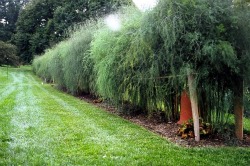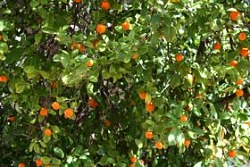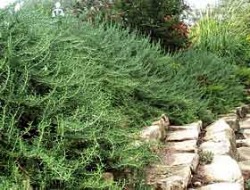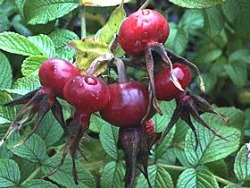
Asparagus makes a beautiful edible hedge when the ferns are allowed to grow after harvest and supported with fencing.

In warm areas kumquats grow into a dense hedge and yield delicious small fruits that are a great for snacking.
Hedges are a ubiquitous part of most landscapes, especially in urban and suburban areas. Homeowners often grow hedges to define their
property line, block an unsightly view, or keep animals and people from
wandering through their yard. Hedges are friendlier than fences and
offer the edible gardener an opportunity to grow some delicious fruits
and vegetables for themselves and their neighbors. Growing an edible
hedge is a good way to soften the blow of blocking out a neighbor's
yard. With an edible hedge you can offer sweet berries and vegetables
they can harvest on their side of the property line.
There are some things to keep in mind when growing an edible hedge in your yard. Decide the function of the hedge before planting. If you
really want to keep wildlife or neighborhood dogs out of your yard
select hedge plants with sharp thorns such as blackberry, gooseberry,
and rugosa rose. Plant these thickly so they fill in quickly, forming
an impenetrable wall.
Consider the ultimate height of the hedge if you're growing it to block a view. While hedges can be trimmed, most edible hedges will look
their best, and produce the most fruit, if allowed to grow to their
natural height. If you only want a hedge to grow 3 to 4 feet tall it's
better to select bush cherries instead of American cranberry (Vibrurnum trilobum)
bushes. American cranberry will grow to 8- to 10-feet tall and won't
appreciate frequent trimming. Select a few different varieties of each
fruit to insure cross-pollination and fruit production.
Many edible hedges are deciduous, meaning they will lose their leaves in winter. If you want an edible evergreen hedge consider
citrus, natal plum, sweet bay, and rosemary. Of course, you'll have to
live in a climate where these shrubs are hardy and will survive.
While most of the attention for edible hedges goes to berry bushes, don't forget vegetables and nuts. Once the ferns have grown up,
asparagus makes a beautiful edible hedge if properly fenced. Corn and
sorghum make a thick row that can block a summer view and provide
vegetables. Nut bushes, such as filberts and hazelnuts, make an
attractive hedgerow while providing edible nuts for wildlife and people.
You can also train fruit trees into fences and hedges that make crossing difficult. Espalier and Belgium fences take apples, cherries,
peach, figs, pear, and citrus trees and turn them into an edible fence
that provides fruit and blocks a view or entrance. I still fondly
remember the edible fences at Thomas Jefferson's home in Monticello,
Virginia that define the garden beds.

Where hardy, rosemary can grow into a beautiful low growing hedge offering attractive blue flowers, wispy foliage and a memorable scent.

To keep animals out of your yard, consider growing a thorny hedge using
roses such as Rosa rugosa. you'll also get attractive and edible hips
to eat too.
Also, consider the growth habit of the hedge. Brambles and roses are some of the plants that will spread by underground roots. This could be
a benefit if you want your hedge to fill in quickly, but also can get
out of control when suckers show up in flower beds and other unwanted
areas.
Finally, instead of planting all of one type of shrub, consider a mixed hedge. Mixed edible hedges provide diversity of plants for
wildlife and an interesting mix of foliage, flowers, and berry colors
and textures. While the shrubs don't all have to be the exact same size
in the hedge, it's good to select ones that are similar in growth
habits so that no one shrub dominates the hedge.
Most of all have fun with your hedge plants. Get creative about mixing and matching plants and experiment with different edibles. Many
gardeners don't think of the hedge as a place to grow food, but
especially in urban and small space yards, hedges offer a new
opportunity to plant even more food for yourself, you family, and
neighbors.
Here area few hedge shrub possibilities to try in your yard. Most hedges grow best in full sun on well drained soil unless otherwise noted.
Bush cherry and plums – Bush cherries and plums offer an easy way to grow these hardy fruits in a yard where you may
not have the room for the tree versions. These bushes grow 4-to 6-feet
tall and wide. It's best to plant a selection of seedlings and
varieties to insure pollination and fruiting.
Natal plum – Although only hardy in frost-free areas, the natal plum is an evergreen with white flowers and small red
fruits. Tall varieties grow to 8 feet and the berries make an excellent
jam and jelly.
Roses – The best roses to grow as a barrier are hip-producing selections such a rosa rugosa and its hybrids such as
'Hansa'. The roots send up suckers and produce a solid hedge in a few
years time with little care. Use the hips for making jams and teas.
Rosemary – Hardy to USDA zone 7, in warm areas rosemary makes a great low growing, 3- to 5-foot tall hedge. The bush
grows densely, produces beautiful blue flowers, and the aroma when you
rub against it makes your mouth water for dinner.
Tall vegetables – As I mentioned tall growing vegetables, such as asparagus, sweet corn, millet, and sorghum, can be
grown as a summer screen in your yard. Asparagus is a perennial and
should be planted with care since it will take 3 years in the landscape
to start producing edible spears, but last for many more years as a
permanent planting. After harvest season in spring the ferns will grow
and provide a visual block when propped up with fencing. Select old
fashioned or tall varieties of corn, millet, and sorghum and plant in
multi-row blocks to insure the screen stay erect all summer. If you
only plant a row or two, the summer winds may blow them over.
Brambles – Blackberries and raspberries make great 5- to 6-foot tall hedges. However, the plants sucker freely and will
spread into lawns and other garden if you aren't careful. Select
everbearing varieties that will produce fruit and summer and fall and
prune in summer only to remove dead canes.
Currants ands gooseberries – Red, white and black currants and gooseberries form a low, 4-foot tall hedge loaded with
berries for fresh eating and juicing. Some varieties will have thorns
and others not, so select the right varieties depending on the use.
Views: 21
Replies to This Discussion
-
You are welcome, Audrey...and I thank you for saying so!
-
© 2025 Created by Aggie.
Powered by
![]()